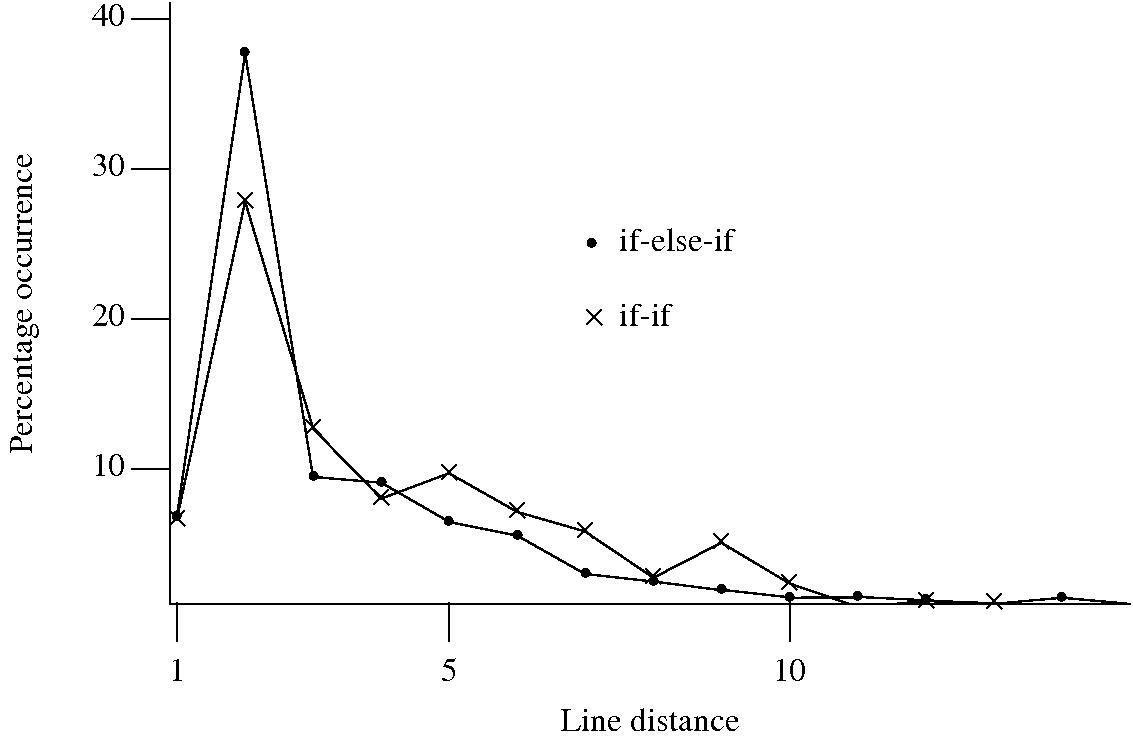Archive
To if-else-if or if-if, that is the question
I am currently measuring if-statements, occurring in visible source, that might be mapped to an equivalent switch-statement. The most obvious usage to look for is a sequence of if-else-if statements that all involve the same expression being tested against an integer constant, as in
if (x == 1) stmt_1; else if (x == 2) stmt_2; else if (x == 3) stmt_3; |
Another possible sequence is:
if (x == 1) stmt_1; if (x == 2) stmt_2; if (x == 3) stmt_3; |
provided all but the last conditionally executed arms do not change the value of the common control variable (e.g., x).
I started to wonder about what would cause a developer to chose one of these forms over the other. Perhaps the if-if form would be used when it was obvious that the common conditional variable was not modified in the conditionally executed arm. This would imply that there would be more statements in the arms of if-else-if sequences than if-if sequences. The following plot of percentage occurrence (over all detected if-else-if/if-if forms) of line number difference between pars of associated if-statements (e.g., when the controlling expression occurs on line

Just over a quarter of the arms contain a single statement (or to be exact the code is contained on a single line); this suggests that when using the if-else-if form most developers put the else and if on the same line. At the next distance along the percentage of if-else-if forms is twice as great as the if-if, probably because of else and if appearing on separate lines (as in the introductory example) in one case and less frequently a comment/blank line in the other. Next along, why the big increase in if-if forms? A comment + blank line, or perhaps no comment or blank line but the use of curly brackets (this is too off the track of where I am supposed to be going to investigate).
This morning I realized why the original plot did not look right, one of the data sets was a way off adding to 100%. An updated version has been uploaded.
It turns out that a single statement (or at least a single line) is more common in the if-else-if form, the opposite of what I had expected. At slightly larger distances there are still differences that can be attributed to else and if appearing on separate lines, curly brackets and a comment/blank line, but the effect is not as large as seen in the original, less accurate, plot.
I have a feeling that I ought to say something about the if-else-if form being preferred to the if-if form. One of the forms will have its behavior changed if the common control variable is modified in one of its arms. But is this an intended or unintended behavior? What is the typical characteristic usage of a common control variable, e.g., do they tend to be accessed but not modified in a given function definition? At the moment I see no obvious cost or benefit strongly favoring one usage over the other, so I will remain silent on the issue.
Recommendations for teachers of programming
The software developers I deal with usually have at least 3 or more years professional experience in industry (I have not taught a beginners programming class in over 25 years) and these recommendations are based on what I tell these people. I like to think that they are applicable to teaching those with a lot less experience.
First. Application domain expertise generally has greater value than programming expertise. That is, an investment of time in learning the application domain will yield a greater return on investment that learning more programming techniques.
Implications:
Second. Computer time is cheap, people time is expensive.
Implications:
Third. Most software is written to solve an immediate problem, used a few times, and then forgotten about (I know of software projects costing in the millions where the code was never used; my own contribution to never used code is somewhat smaller, but still much larger than I would have liked). The point is that writing software involves a cost/benefit trade-off, how much should I invest in making code maintainable given the risk that the benefits from this investment may not be recouped.
Implications:
Fourth. Don’t fool yourself that you are teaching programming; you probably just give a lecture or two and expect students to pick up the details from one of the assigned course books.
Implications:
Fifth. Coding style does exist and can have an effect on the cost of writing and maintaining code as well as how well a compiler can optimize it. These costs and benefits vary with the context in which the code was created and used. A good programmer will adopt a coding style appropriate to the context, just like an actor plays a role with the appropriate characterization (eg, comedy, thriller, suspense). It takes more experience than most undergraduate have to be able to properly discern what style is being used, let alone be capable of changing their own style.
Implications:
Recent Comments